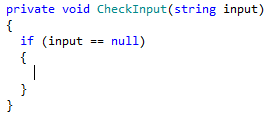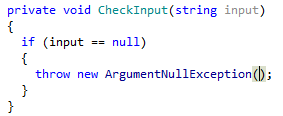Postfix Templates
Postfix templates help you transform expressions that you have already typed without jumping backwards — just type a dot after an expression and pick a template from the completion list.
Apply postfix templates
One of the simplest examples of postfix templates is negating a boolean expression. Suppose you have just typed a boolean expression and then realized that the comparison logic should be reversed. Normally, you have to move your caret back and change == to != or vice versa, and then return to where you were. With JetBrains Rider, you can just continue typing .not and press Enter.
There are a lot more postfix templates that you can use to speed up coding. For example, you can wrap the current expression with if, while, lock, using, add return, yield return, await in front of the current expression, iterate over a collection, generate a switch statement, cast the expression to a specific type, or even introduce a field or property for the expression.
Postfix template could even change your typing routine. Consider the CheckInput method below and imagine how you would type the null-checking clause.
Now let's see how you could do it with postfix templates.
As soon as your caret is in the method body, you can start typing input right away because that is what you want to check. When the input is there, just continue typing .null- a postfix template for checking the expression for null:

This will compare input with null and wrap the comparison in an if statement, and set your caret at the position where you can continue typing:

Now, instead of typing throw, you can go ahead with typing the exception class name, and invoke the .throw template after it:

After applying this template, you have the complete throw statement, and the caret at a place to enter arguments:

You could see that instead of typing frequently used language constructs manually, in many cases you can type just a couple of initial characters of a template shortcut and get everything in place, properly formatted and without typos.
Apply a postfix template
Type a dot after the current expression and check the completion list for the desired templates.
If you know the shortcut of the template that you are going to apply, start typing it — this will shrink the list of suggestions.
As soon as the desired template is selected in the suggestion list, press Enter.
- If the template has editable parameters (that is, requires user input), JetBrains Rider deploys a Hot Spot Session in the editor and sets the input position at the first parameter. Then you can do the following:
If JetBrains Rider suggests some values for the current parameter, use Up and Down arrow keys to navigate through the list of suggested values, or just type in a desired value.
Press Tab or Enter to accept the value and move to the input position of the next parameter. If this is the last parameter, the hot spot session completes and the caret moves to the end position defined for the session.
Press Shift+Tab to move the input focus to the input position of the previous parameter.
Press Esc to exit the hot spot session. In this case, all session parameters will be initialized with default values.
List of postfix templates
| Shortcut | Description | Example |
|---|---|---|
| .arg | Surrounds expression with invocation | Method(expr) |
| .await | Awaits expressions of 'Task' type | await expr |
| .cast | Surrounds expression with cast | ((SomeType) expr) |
| .else | Checks boolean expression to be 'false' | if (!expr) |
| .field | Introduces field for expression | _field = expr; |
| .for | Iterates over collection with index | for (var i = 0; i < xs.Length; i++) |
| .foreach | Iterates over enumerable collection | foreach (var x in expr) |
| .forr | Iterates over collection in reverse with index | for (var i = xs.Length-1; i >= 0; i--) |
| .if | Checks boolean expression to be 'true' | if (expr) |
| .lock | Surrounds expression with lock block | lock (expr) |
| .new | Produces instantiation expression for type | new SomeType() |
| .not | Negates boolean expression | !expr |
| .notnull | Checks expression to be not-null | if (expr != null) |
| .null | Checks expression to be null | if (expr == null) |
| .par | Parenthesizes current expression | (expr) |
| .parse | Parses string as value of some type | int.Parse(expr) |
| .prop | Introduces property for expression | Property = expr; |
| .return | Returns expression from current function | return expr; |
| .sel | Selects expression in editor | |selected + expression| |
| .switch | Produces switch statement | switch (expr) |
| .throw | Throws expression of 'Exception' type | throw expr; |
| .to | Assigns current expression to some variable | lvalue = expr; |
| .tryparse | Parses string as value of some type | int.TryParse(expr, out value) |
| .typeof | Wraps type usage with typeof() expression | typeof(TExpr) |
| .using | Wraps resource with using statement | using (expr) |
| .var | Introduces variable for expression | var x = expr; |
| .while | Iterating while boolean statement is 'true' | while (expr) |
| .yield | Yields value from iterator method | yield return expr; |